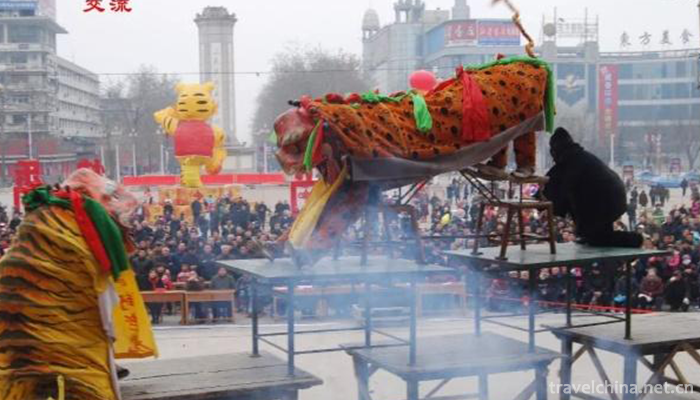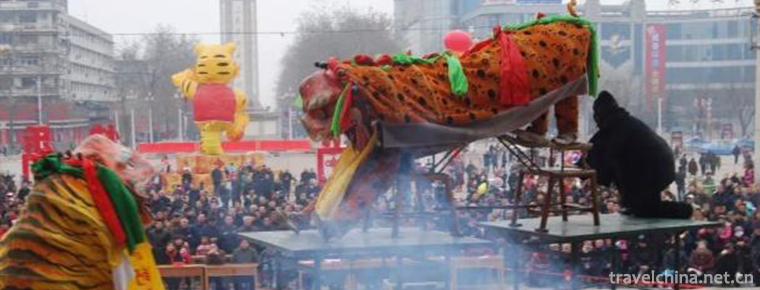Tiger dance shua laohu
Tiger dance shua laohu
Tiger dance, also known as "playing tiger" ("playing" Jiaozuo dialect refers to "playing" and "performing"), is said to have appeared in the Western Han Dynasty and spread in the middle reaches of the Yellow River. Jiaozuo "playing tiger" dance can be traced back to the Ming Dynasty. Jiaozuo's ancestors were inspired by tiger's boldness and action of Teng, Jump, Push and Lie. They created and compiled the traditional folk dance of tiger dance, also known as "playing tiger", with tiger's vigor, agility, vigor and dignity, integrating with local cultural characteristics, or martial arts, or sacrifice, or interpretation of local stories.
The tiger dance in Xizhou Village originated from the activities of sacrificial Association in Ming Dynasty. It went through five stages: emergence, development, decline, recovery and revitalization. From the end of Qing Dynasty to the beginning of the Republic of China to the 1930s, it was the first flourishing period. At that time, tiger dancing was combined with martial arts. Then it was inspired by traditional operas and folklore to strengthen its plot and interest, to compile the performance of instrument fighting tigers, and to arrange tiger table, chair and tower performances according to the characteristics of tiger's bravery and skillful climbing, so as to make tiger dancing in the village in a regular way. Mould and performance skills have been greatly improved, and many excellent performers have emerged. After the War of Resistance Against Japan, it gradually declined; after liberation, it gradually recovered; and in the 1990s, with the tide of reform and opening up, it has made great progress. From single tiger performance to group tiger performance in the past, personal performance technology has also been greatly improved. It can perform small and delicate performances on the stage and large-scale group tiger performances in the square. Therefore, no matter in artistic appreciation or in setting off a warm atmosphere, it has an irreplaceable role in other folk arts and shows its unique artistic value.
Xiaoshangcun, Zhongzhan, has a strong traditional national culture atmosphere. Tiger dance, a wonderful National culture, is rooted in this fertile land. Xiao Shang Tiger Dance was created by Zhang Shuting, the ancestor of Xiao Shang Village, in Daoguang Period of Qing Dynasty. Zhang Shuting practiced martial arts at an early age and was happy to participate in village temple fairs and festivals and traditional festivals. Around 1850, it combined martial arts with folk dances and folklores, and created the folk dance of "playing tigers". After more than 160 years of inheritance for 10 generations, it has gradually been refined into a classic folk dance composed of six road tiger stands, flat tiger, Hill tiger and mountain tiger. The tiger dance performance is composed of two parts: the honor Bang band and the tiger stand. The basic performing procedure is that in the sound of drum music and fire brass, all kinds of martial arts actors shout for encouragement and play, and then the tiger players with guns enter the arena first, tease the tiger with martial arts routines, and with the surging rhythm, sound of fire brass, the tiger dance makes a flutter, bite, toss and tosses on the arena or on the high platform (hills, mountains). Move, jump and other dangerous movements, and around the field performance, or rapid running, jump, or slowly move its performance scene is magnificent and warm, on-site and off-site echoes, shaking the world. The whole performance was successful in stimulation and oscillation. It was very ornamental and artistic.


-
1.Steamed Abalone with Sharks Fin and Fish Maw in Broth
Buddha jump wall, and the name of the altar full of fragrance, Fu Shing, is a famous local cuisine in Fuzhou, Fujian, belonging to the Department of Fujian cuisine. According to legend, it was develop
Time 2018-11-02 -
2.Mianzhu New Year Picture Village Scenic Area in China
New Year Picture Village is located in Xiaode Town, South Gate of Mianzhu City, Sichuan Province. It is located between De'a Highway and Chengqing Highway, 73 kilometers away from Chengdu and within o
Time 2018-12-22 -
3.Tibetan Cobalt Technology
Zhang Zhaxi, a Tibetan cobalt-smelting craftsman over half a century old, told reporters that he was just "catching its tail" when the craft was losing its popularity.
Time 2019-04-15 -
4.Jamal
In June 2008, Chamane declared by Alxa League of Mongolian Autonomous Region was listed in the second batch of national intangible cultural heritage list with the approval of the State Council.
Time 2019-04-15 -
5.Li Nationalitys Wood Drilling and Fire making Techniques
Li people's wood-drilling and fire-making skills, Hainan Province's local traditional handicraft, one of the national intangible cultural heritage.
Time 2019-05-13 -
6.Mongolian yurt building skills
Mongolian yurt building skills, the traditional local skills of Xiwuzhumqin Banner and Chenbalhu Banner in Inner Mongolia Autonomous Region, one of the national intangible cultural heritage.
Time 2019-06-03 -
7.Legend of the ancestors of Khitan
The legend of the ancestors of Qidan is a folk legend that is spread in Pingquan County, Hebei Province, China. According to legend, the ancestors of Qidan were born on the Futu River in Mayushan
Time 2019-06-10 -
8.Legend of Emperor Yan Shennong
Yan Emperor Shennong, one of the three emperors and five emperors, is one of the local folklores in Suizhou, Hubei Province, and is the national intangible cultural heritage. After Wa Fuxi, a stepdaug
Time 2019-07-10 -
9.Yangzhou Tanci
Yangzhou's performance of ci-poems is mainly based on speech and supplemented by singing and playing. The representative bibliographies are "Double Gold Ingot", "Pearl Tower", &quo
Time 2019-07-10 -
10.Yi sea
The Yi sea is also known as the fish sea, and the local Yi people are called Su pin. It is located in Yangping mountain, Yihai Town, 40 km north of Mianning County. It is 330 km away from Chengdu, the capital of Sichuan Province
Time 2020-10-15 -
11.Xianshi ancient town scenic spot in Zigong City
Xianshi ancient town scenic spot in Zigong City stands on the Bank of Fuxi River 11 kilometers southeast of Zigong City, the "Millennium salt capital", which is in contrast with Zigong, a famous historical and cultural city.
Time 2020-10-15 -
12.Meishan climate
Meishan city is located in the middle and low latitudes, located in the west of Sichuan Basin and the middle reaches of Minjiang River. It is characterized by the alternation of sea land monsoon every year. It has four distinct seasons, mild climate, abundant rainfall,
Time 2020-12-18